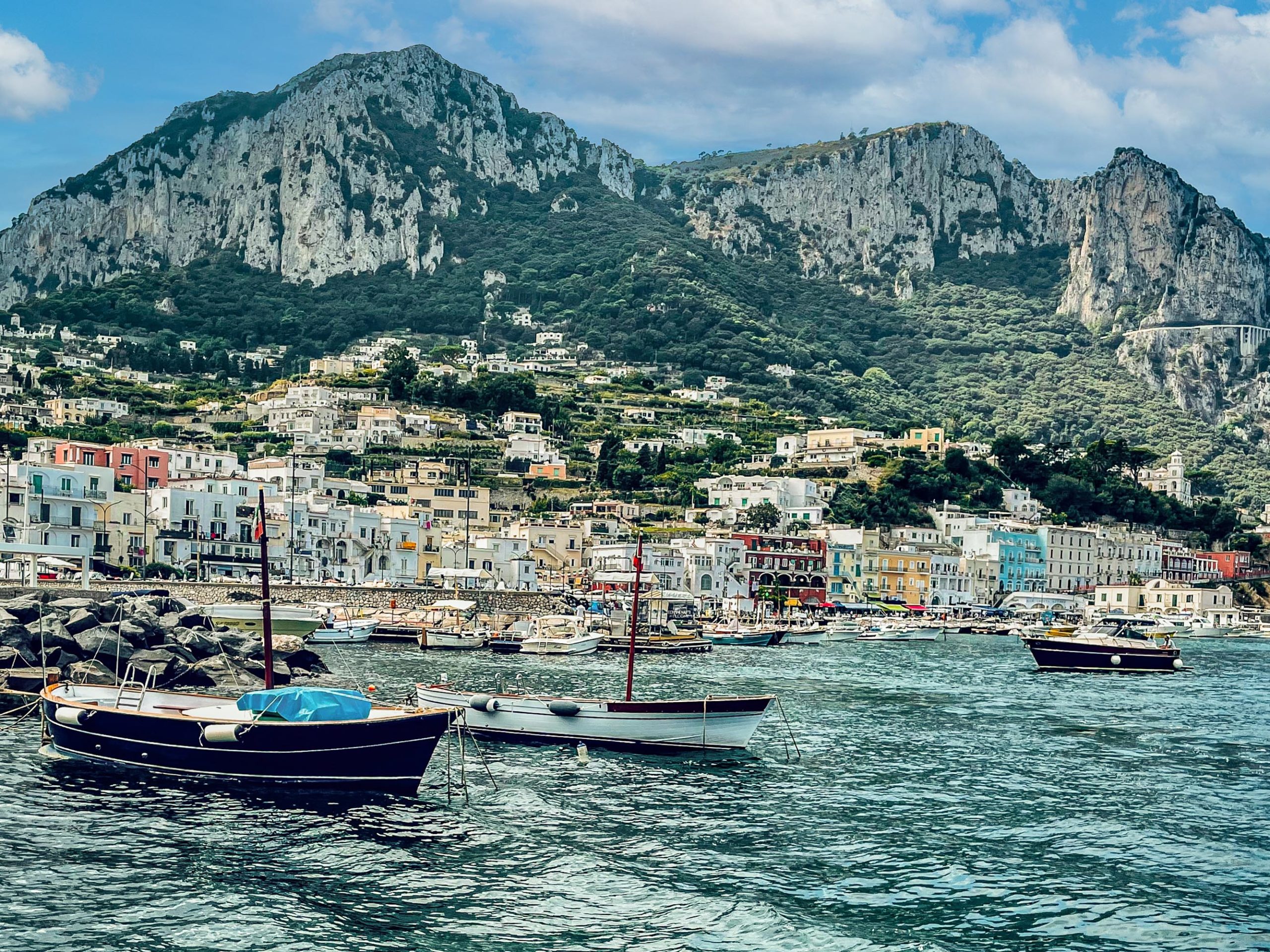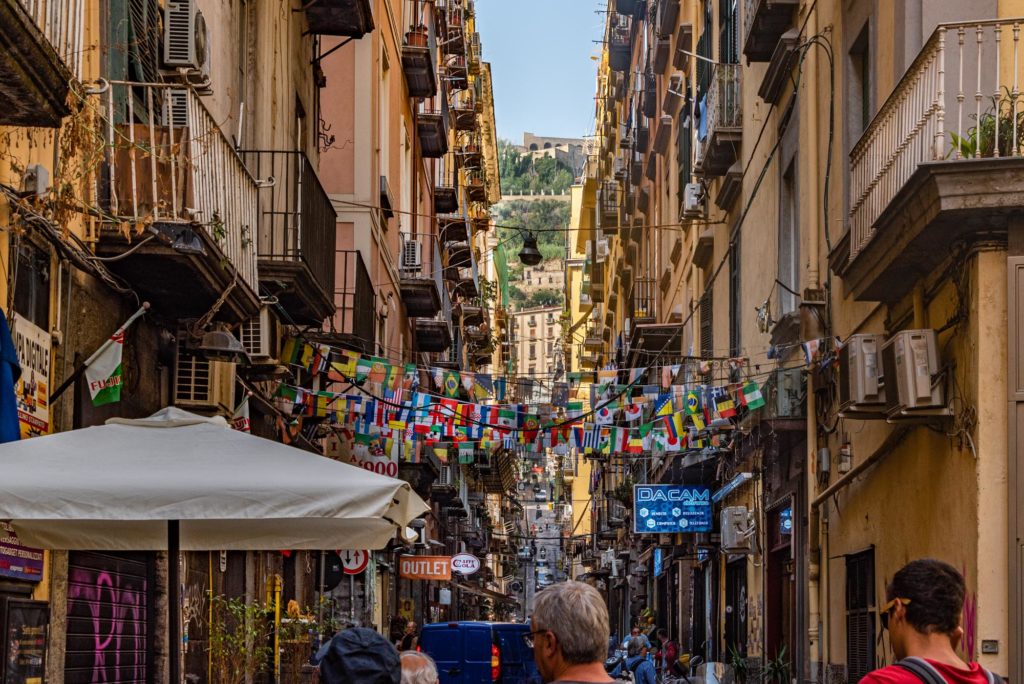“Stay away from the Spanish Quarter. It’s dangerous!” The young man sitting in front of me on Amtrak’s Northeastern Corridor train from Philadelphia to Newark International Airport advises. Rick and I fly out of Newark on a two-stop flight ending in Naples, Italy, in a few hours. We’ll join a group to tour the city and explore the Amalfi Coast for ten days.
“Make sure you try Sorbillo’s pizza,” he continues, “and don’t miss the sculpture The Veiled Christ at the Sansevero Chapel Museum.” As it turns out, I was unable to take any of his helpful hints; we couldn’t obtain tickets to see the famed marble sculpture.
MAMMA MIAAAAAAAAAAAA. The large block letters on the side of an orange jetway make me smile as we deplane and pile into a shuttle for the terminal. The city’s Italian name is Napoli. I quickly adopt it.
From conversations with locals, Italy’s third largest city gets a “bad rep” from Italians in Rome and the north. Neapolitans are the poorer, less sophisticated cousins living in a gritty, dirty city run by a destructive Camorra (a local crime organization). These are the allegations. Not a world class city like Rome, nor fashionable or cultural like Milan. Even the media levies criticisms on Napoli for its unkempt appearance. And in our first day of a four-day stay, I must admit Napoli does have a housekeeping problem.
But as a longtime resident of beloved Philadelphia, I’m familiar with complaints about our own city’s litter and trash problem, its grittiness and working-class mentality, and even the presence of a homegrown crime cartel. Philly’s population still represents a significant Italian sector, and Philadelphia had the second-highest percentage of Italian-Americans of any American city as of a decade ago. Most Philly-Italian families migrated from Southern Italy––Sicily and Naples.
These accusations about Napoli pique my curiosity. I’m eager to see it in action, especially to visit the “dangerous” Quartieri Spagnoli, the city’s Spanish Quarter.
We stay in Piazza Bellini in old town’s center, the largest “old town” in Europe and a UNESCO World Heritage Site. History, religion, and the essence of a vibrant culture seep through the streets and walls and intoxicate the senses.
We throw caution to the winds
I relate my Amtrak train conversation warning about the Spanish Quarter to our guide, Sergio Scardia, owner of Italy Gay Travels. He laughs. “That’s just where I’m taking you!” With our cohort in tow, he leads us through a long stone archway lined with open-air stalls selling tee-shirts, records and CDs, posters, and trinkets. The arch opens onto vast and crowded Piazza Dante, named for the poet and philosopher whose bronze likeness overlooks and protects us, I imagine, from wandering into the Inferno. Small herds of young people fooling around, lovers holding hands and necking, shoppers toting bags of purchases, young boys playing kickball while mothers referee––Naples lives here on the streets.
We pick up the main boulevard, Via Toledo, lined with lots of upscale retail stores. I pass a woman on a stepladder changing the exterior window display of a trendy shoe store. She eyes me a bit suspiciously as I photograph street action. Without an intelligible exchange of words, I point to a pair of leather sandals I admire and then to myself. She looks down at my feet and motions they are way too big for what she has. Sign language remains an effective communication tool.
What impresses me are the rows of venerable and architecturally handsome structures that line the street, representing various historical periods. Today, many bear distracting, disappointing graffiti as they wait patiently for considerable cosmetic treatment. Black and white-painted wrought iron balconies set off rows of windows with decorative pediments often displaying concrete medallions of finely feathered birds and gryphons. Many balconies are full-length doors with aging wooden shutters attached. They suggest Napoli’s bygone glory days as a major Mediterranean port, capital of the once-Kingdom of Naples, capital city of the Kingdom of The Two Sicilies, and a center of enormous wealth and noble families.
When General Giuseppe Garibaldi wrought the unification of various kingdoms, republics, and city-states into the country of Italy in 1860, a huge portion of Napoli’s financial resources was siphoned off to Rome to establish the new capital as the economic, cultural, and social center. Over four million people emigrated from the region: many to America and especially its East Coast cities including Philadelphia, depleting the work force. Naples and Southern Italy declined in power and status.
A right turn brings us to the entrance of two diverging streets, both narrow, crowded, lined with shops, and festooned overhead with hundreds of small flags of Italy, Napoli, and family coats-of-arms flapping on cords connecting the two sides of the street. They share the upper stories with clotheslines full of this morning’s wash. We enter the infamous Quartieri Spagnoli and turn onto Via Forno Vecchio.
Since its founding in 600 B.C. as a Greek colony (Neapoli, “new city”), several civilizations ruled Naples. During the 1600s, Spanish rulers carved a section of land to build a tight grid of narrow, 10-foot lanes bordered mostly by five-story buildings lining them as a military garrison for troops. The concentration of young soldiers encouraged rowdiness, crime, and inevitably prostitution. When Spain departed, a poorer population with less structured lives backfilled the area, and the Spanish Quarter gained a reputation as the neighborhood to avoid. Even today the Quartieri Spagnoli remains packed with residents spending many of their waking hours on the streets. Markets selling produce, meats, and household goods, with an abundance of pizzerias and other eateries, produce a lively experience. Naples is arguably the home of the world’s most famous Italian culinary dish. Noisy with music, motorcycles, and vendors, it’s now a destination for visitors chasing the “authentic” Naples they see in movies and television.
Pignasecca Market excites the senses
Everything––walking, shopping, eating, talking, arguing, yelling––happens on these streets paved with large-blocked cobblestones. Undersized delivery trucks and small cars nudge people onto the informal sidewalks delineated by iron bollards. I dive left as a motorcyclist plows his way through the crowd. As I approach the lane’s next intersection, a cacophonous hum of excited voices grows until the Pignasecca Market sprawls into a panorama before us on its piazza, side streets, and narrow lanes. The market pulses with the voices of shoppers and vendors as we plunge into the crowd among the market’s kaleidoscope of stands and stalls. I love to visit local markets for their tantalizing spreads of produce, meats, and fish alongside the wide assortment of household items cleverly displayed. Markets tell you about regional cuisine and can reveal unique transactional customs between seller and buyer. As a port city, Neapolitan cuisine relies heavily on frutti di mare (sea food) and these displays introduce me to interesting marine wonders. Among them, a huge pile of entangled octopi catches my eye. To the right of its suckered tentacles is an ugly-as-sin whole monkfish, its wide, almost cylindrical body terminating in a flattened head and cloudy eyes topside covered in a mottled gray-brown skin. What looks like a big smile bears razor-sharp teeth while its body yields one of my favorite meats. Gigantic prawns, buckets of different sized and colored mollusks, the largest squids I’ve ever seen, and fish of all sizes fill the display. Summer’s cornucopia of vegetables shouts for attention––piles of red, green, yellow, and orange peppers, eggplants, cauliflower, carrots, tomatoes, pumpkins, and apples. Stuffed and fried zucchini flowers regularly appear on Italian menus, and dozens of the green squashes stand upright on end in rows with their closed blossoms still intact on top.I discover a shop with its front window filled with cow, sheep, and pig innards. Stomach or tripe, a popular item on Italian dinner tables, intestines and lungs hang on meat hooks while the butcher arranges hearts, kidneys, livers and other viscera below. A customer asks the butcher to show her several pieces of a particular organ before she makes her selection. The suspended display fascinates me, the individual specimens almost beautiful, but the thought of chomping down on any of the organs flips my stomach. Next door a vendor sells street food in large brown paper cones––fried calamari and fried alici (fresh anchovies, no oil), which I discover aren’t strongly fishy at all.
Napoli breathes deeply with life
As in other neighborhoods, Quartieri Spangoli’s walls are covered with graffiti. Neapolitans must have given up trying to control it, or maybe it’s a strong cultural custom: the ancient Romans also indulged in defacing surfaces. As we walk along Via Lungo del Gelso, pervasive wall graffiti occasionally makes room for small murals, sometimes painted directly onto surfaces and others applied like posters. I’m taken particularly with a poster depicting one of Italy’s national treasures, Sophia Loren, dressed as a buxom farm girl with a polka-dot ribbon in her hair, a visual homage to grape stomping.
Soccer hero images occur regularly, as does a puzzling graffiti drawing of a snarl of snakes, and there are two unusual pieces criticizing Egypt’s government. Every few blocks I notice rectangular sheets of paper featuring an image of the Virgin Mary plastered to walls, a person’s name in large block letters, plus date and location information. “They’re death notices and funeral announcements,” Sergio explains. Deaths and their attendant funerals and wakes are major community events in Italian culture.
Despite their reputation for boorish behavior, the Neapolitans I encounter typify gruff “big city” attitudes, and that’s the way it is in my hometown. But these Neapolitan Italians are often friendly and welcoming, too. Two tourists with telephoto lens cameras photograph a smiling baker standing outside her panatteria (bake shop), her outstretched arms each holding a dish with a freshly baked sfogliatelle, made with layers of puff pastry supposedly resembling a lobster’s tail (translation of its name). Filling these flaky desserts sprinkled with powdered sugar are ricotta cheese, sugar, eggs, and candied lemon. I sample one later to confirm their deliciousness.
A Word to the wise
So, the Quartieri Spagnoli isn’t so dangerous after all. Neapolitans managed to turn this once menacing area into one of the city’s tourist attractions. Maybe it does serve as one of the last vestiges of Napoli as depicted on movie and TV screens. There’s one caveat, however, the visitor should heed. Don’t go wandering deep into the neighborhood at night. If ill luck befalls you, it could be your own undoing.If You Go
Getting There
By Air––Major U.S. and European airlines fly daily to Naples International Airport, located about four miles north of the city. From the U.S., all flights make one stop in Europe first. European discount airlines––Ryanair, easyJet, Volotea, and Wizzair––also make daily stops.
By Train––Italo Treno, Italy’s high-speed bullet, train makes the 70 minute trip from Rome daily.
By Car––it’s a 2-hour ride from Rome on superhighway A1. (Don’t try to keep up with Italian drivers!)
Things to Do—Based on my experience and reports from others; this is NOT an exhaustive list:
Spanish Quarter (of course!)
Visit Pompeii––don’t miss this experience!
Climb Mt. Vesuvius–(we did it!) It’s quite a hike, but worth it to peer into its caldera. Turn around and take in the entire city and Bay of Naples.
Veiled Christ marble sculpture in the Museo Cappella Sansevero––considered “one of the world’s most remarkable works of art.” Purchase timed tickets ahead. Unfortunately for us, they were sold out.
San Gennaro Catacombs––Underground Paleo-Christian burial and worship sites with fifth and sixth century frescos.
Piazza del Plebiscito––beautiful, elegant stately public buildings
Naples Cathedral––big WOW factor
Churches, Churches, Churches––check out Tripadvisor or some other “Best of” list. There are soooooo many.
Via San Gregorio Armeno––(also known as Christmas Alley), narrow lane in the heart of old Naples, packed with shops selling religious art. Fun place to visit, even if you don’t usually dress up in your Sunday best to meet the preacher.
Convent of San Gregorio Armeno––impressive ornate church on the same street.
Isle of Capri Harbor




